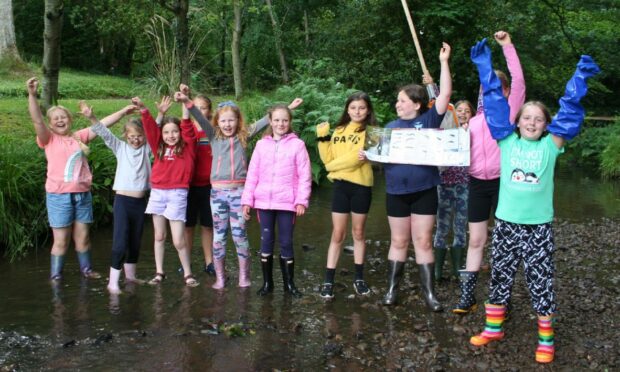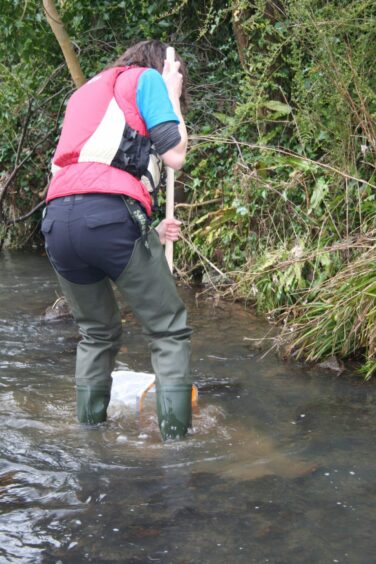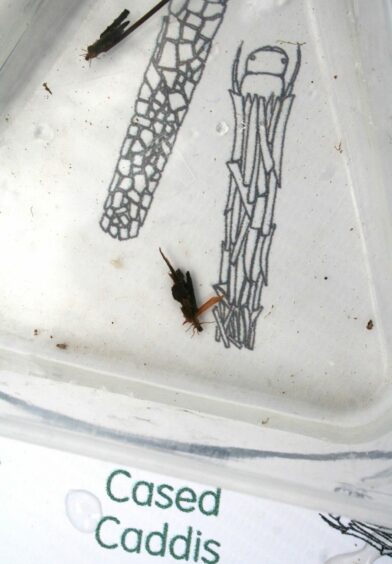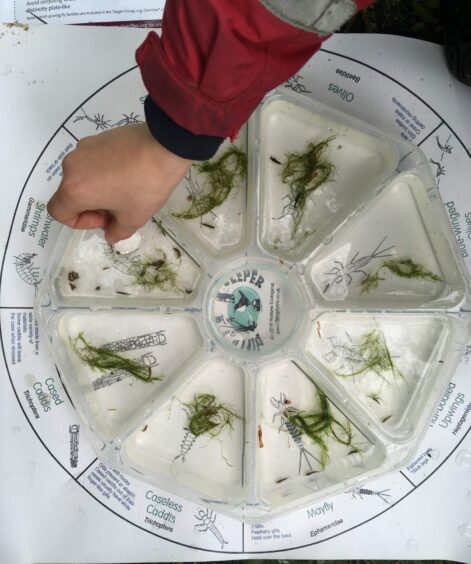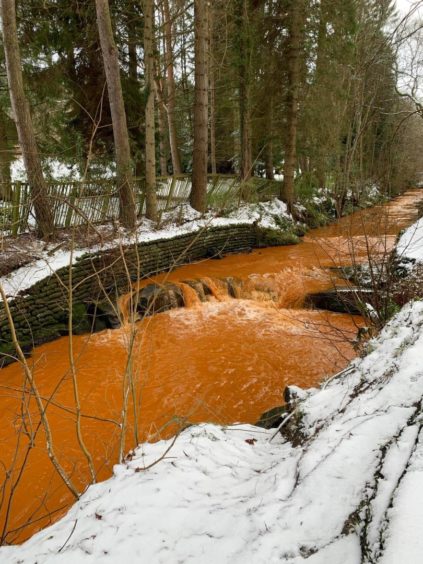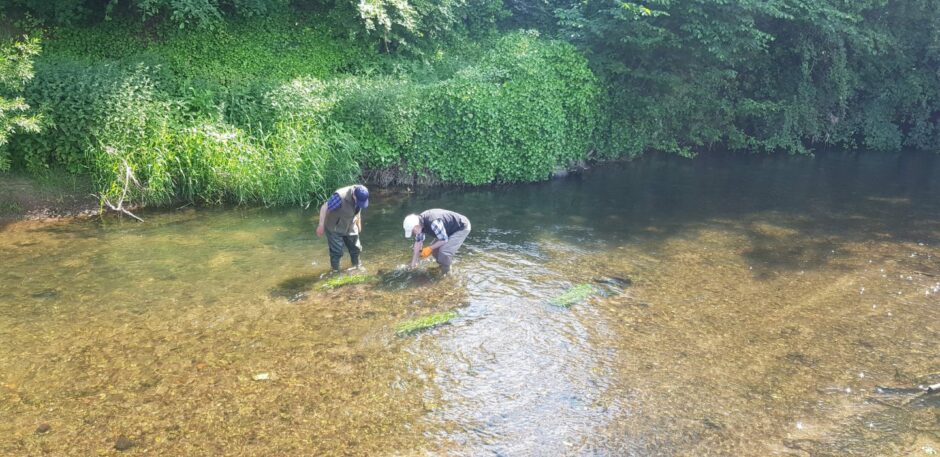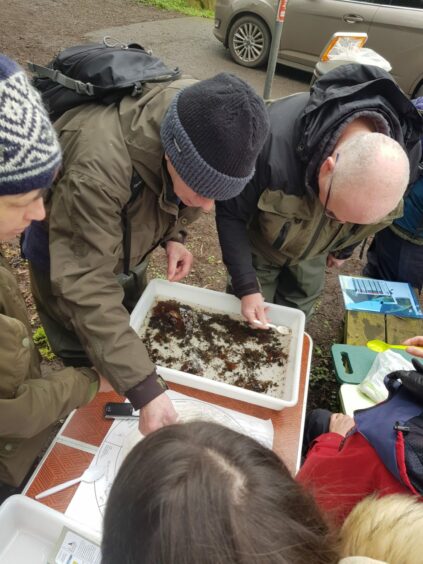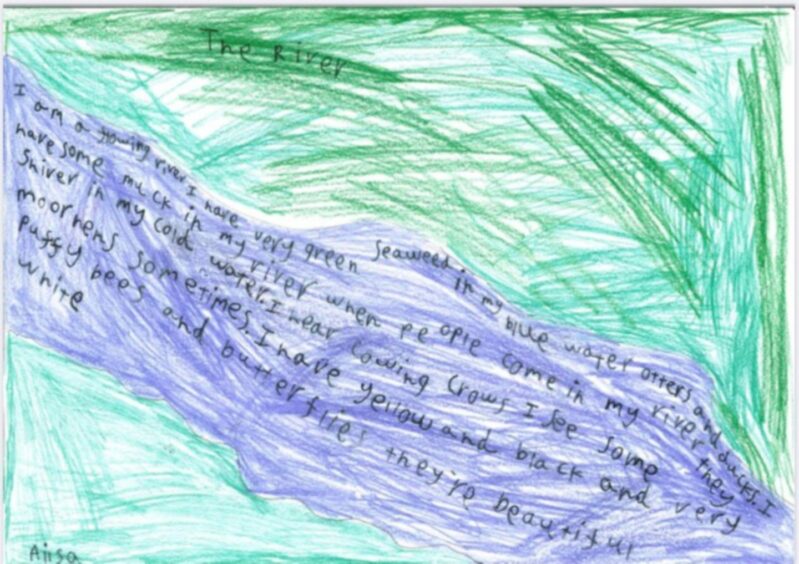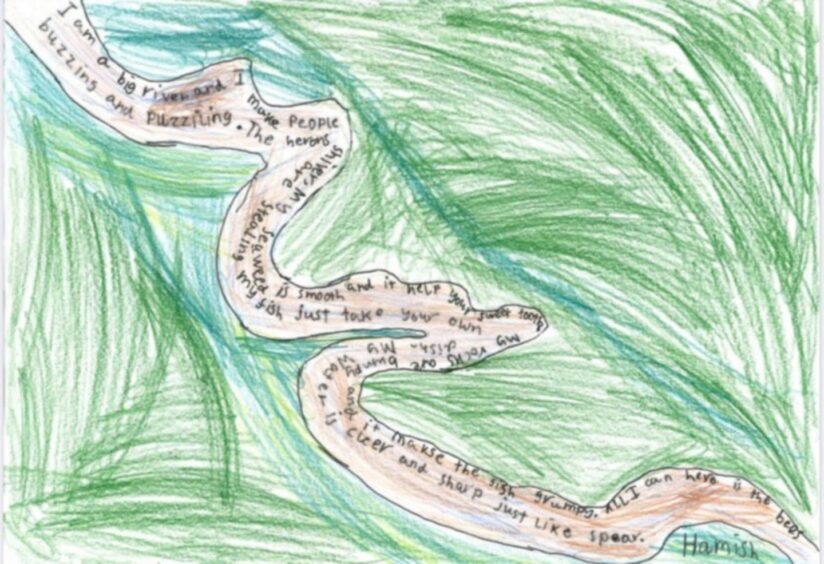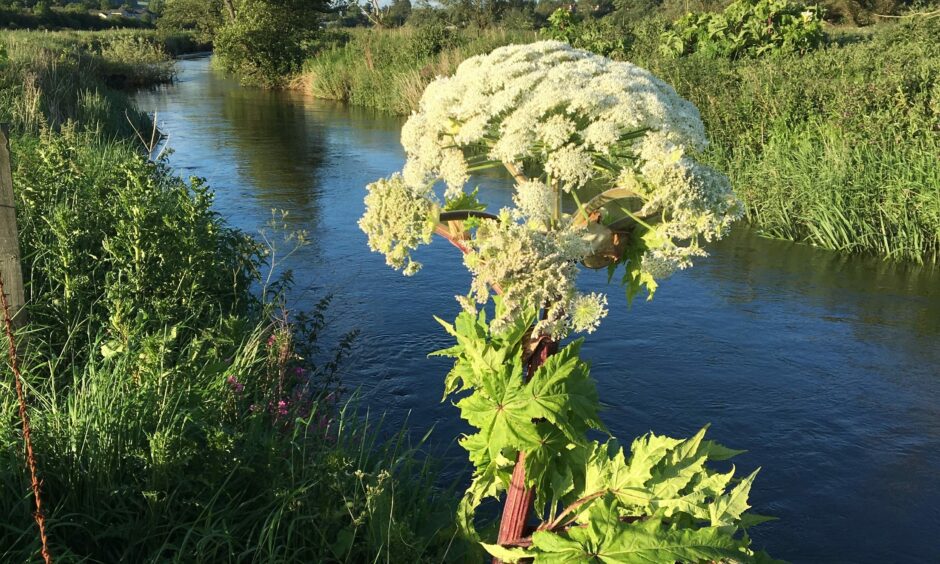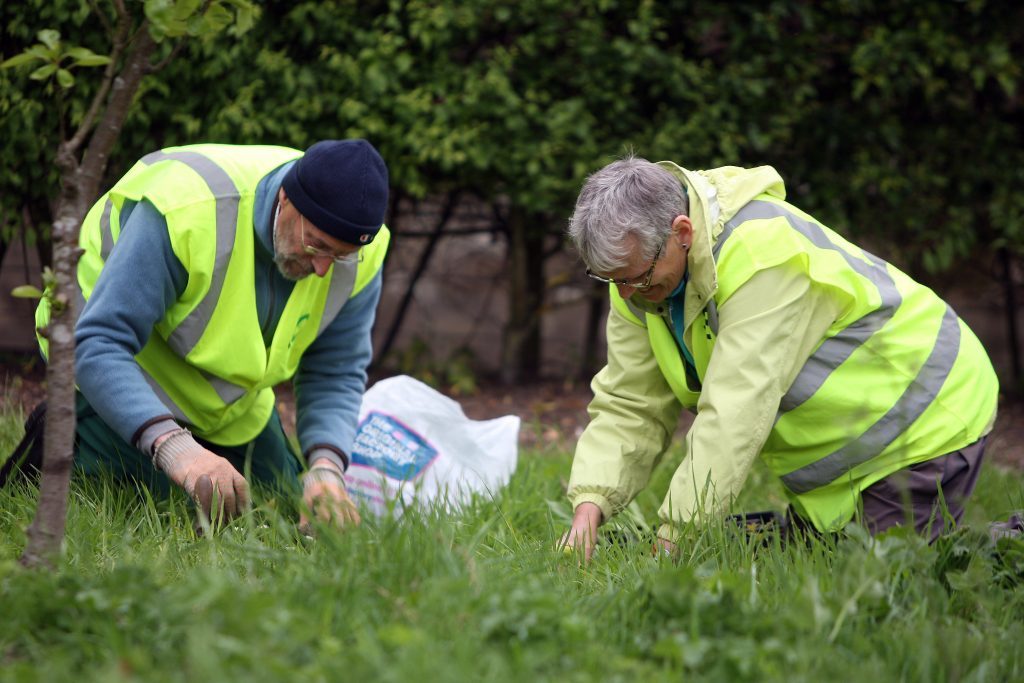Squeals of excitement fill the air as children who’d spent the morning hunting for wildlife find what they’d been hoping for.
“Shrimp!” shouts one child.
“Caddis fly!” shouts another.
What were the children doing?
Minutes earlier, the welly-wearing youngsters had been wading in the St Andrews Kinness Burn, near Hallow Hill, using sampling techniques shown to them by an adult volunteer.
One technique was to stamp their feet to bring up some of the silt and then hold a net to catch the contents.
A second technique was to wear special gloves and gently rub a rock in their hands to release any creatures into a bucket.
Now, as they placed any finds into a special tray, the realisation hit them that there was hidden life in this waterway they never knew existed.
Becoming River Guardians
The youngsters were taking part in a project called “Guardians of our Rivers”.
The partnership project, organised by conservation group Buglife Scotland, aims to connect communities across Scotland with their local rivers and the invertebrates that call these places home.
Freshwater invertebrates are an essential part of the ecology of our rivers.
Yet freshwater wildlife across the UK is under threat as rivers, streams and other freshwater habitats they live in have been damaged and/or polluted.
Benefits of outdoor learning
St Andrews mother-of-three Emma Hughes helps run a group for children who are flexi-schooling on Fridays.
This term their theme has been ecological innovation.
She got to know about the River Guardians project through another parent.
A believer in children being able to get out of the classroom and be “more pro-active” in their learning, it was a chance for the children to learn about their local environment and get their feet wet.
“Often when we talk about the natural world with children, we focus on the truly sexy animals – elephants, giraffes, that kind of thing,” said Emma, who trained as a Montessori teacher about eight years ago.
“Actually, to see them there in the river learning about indicator invertebrate species, then doing the sampling in their wellies.
“Looking through those buckets and trays and finding them.
“They were screaming ‘shrimp’ and ‘caddis fly’ like they’d seen a zebra!
“The excitement and achievement was amazing.
“Honestly, I don’t believe they would have been more excited if they had been on a safari in Africa.
“They were proving that the river was healthier than they’d hoped for.
“That is very exciting for whatever age. And as we all know, better data means better decision making.”
How does River Guardians work?
The Guardians of Our Rivers project aims to recruit, support and train local people who would like to get involved in monitoring the health of their local river.
Training is delivered by Buglife’s qualified Riverfly Partnership trainer.
It offers certified training to volunteers and creates a network of ‘Citizen Scientists’.
The St Andrews session attended by these youngsters was organised by Anya Hart Dyke, Skillshare Coordinator with Transition University of St Andrews.
Currently they are focused on monitoring water invertebrate populations in the Lade Braes.
They meet monthly to do sampling and would welcome anyone interested in learning more to come along and watch or even to have a go.
“I grew up playing and splashing around in rivers down in Kent but never knew the names of any of the beasties I came across,” said Anya.
“But since my training with Buglife Scotland to become a River Guardian, I have finally learned their names and how important they are in the food chain – how much other life they support.
“It makes me fond of them somehow.
“And as a person who’s not bug mad or even that comfortable with slithery things on me, that’s saying a lot.
“As Attenborough has said, you value what you know and understand.
“It’s also very exciting – certainly empowering – as a non-specialist to now know how to judge the health of a river.
“Unless there are brightly coloured swirls or surface foam pointing to chemical pollution, it’s impossible to know how clean the rivers are.”
Part of a wider problem
The poor ecological health of rivers across the entire UK is rarely out of the news.
Anya’s nine-year-old recently said to her: “I’m not interested in nature, but I care about it”.
Children don’t have to want to be a conservationist or a biologist when they grow up.
But they should have a basic understanding of how nature and ecology, of which we are all part, works.
That understanding opens people up to caring about it.
What’s happening at the River Eden?
In the Cupar area, the health of the River Eden, which flows through the Howe of Fife, has also been under scrutiny.
Over the past year, volunteers from several organisations have come together to support the river.
There have been pollution incidents, raw sewage overflows, the disappearance of the vibrant river weed, ‘ranunculus’ as well as increased invasive species on the riverbanks, like Giant Hogweed and Himalayan Balsam.
Members from Sustainable Cupar, the Eden Angling Association, University of St Andrews, Fife Coast and Countryside Trust and local councillor Margaret Kennedy got together and hatched a plan to improve things.
They realised that the most effective way to tackle these problems was to see the river as a living system from source to sea.
Deteriorating habitat
Michael Farrell, secretary of the Eden Angling Association, said: “People in the community have seen the river change for the worse in recent years.
“The habitat for fish and insects has deteriorated.
“The vital and vibrant river weed has gone in many areas and the number of salmon and sea trout have declined.
“We can’t just sit on our hands and watch it get worse.
“We have to do our bit in our local area for nature and the climate crisis, so why not help to restore the river and bring back healthy numbers of our iconic salmon.”
Multiple improvement efforts
Mr Farrell said they had formed a new group called The River Eden Source to Sea Sustainability Project or RESSSP for short.
They are now working with local organisations and landowners across the whole of the River Eden catchment to improve things.
They have already had some important successes:
They have joined the national Riverfly initiative.
Twelve volunteers took part in training by Buglife Scotland officer Rebecca Lewis and on each second Sunday of the month they are carrying out a survey of the river bed.
Volunteers learn to identify eight different bugs that indicate the health of the river.
Involving school children
Later this month they will be doing a Buglife survey with Pitlessie Primary School.
Teacher Anna Latto said: “The pupils are so excited to take part.
“They are going to love looking at the bugs and trying to identify them.
“The river is such an important part of life in their community.
“When they heard about the project, they wrote poems about the river and why they wanted to protect it.
“They definitely want to get involved in being Guardians of the River”.
The group have also been trialling the transplant of river weed to areas of the river that used to have lots of it.
They will need to wait until next year to find out if this has been successful but they are hopeful.
Tackling invasive species
They successfully applied for funding from the Crown Estates Environment Fund to carry out water quality monitoring and this will also take place monthly so that they can find out if there are ongoing pollution issues.
Mr Farrell added: “We are communicating regularly with SEPA and Scottish Water about this and both organisations have been very supportive.
“Our biggest project will be to tackle Giant Hogweed and other invasive species from source-to-sea.
“We will also carry out some river restoration works by planting bankside trees and helping the river to flow more naturally.
“To do this we have applied for funding from the NatureScot Nature Restoration Fund.”
‘Fantastic’ support of communities
Sarah Davidson, chairperson of environmental charity Sustainable Cupar, said they have had “fantastic support” from people in the community up and down the river from Gateside to Cupar to Guardbridge.
“Letters of support have come in from landowners, schools, and community councils,” she said.
“We are also delighted that bodies like Scottish Water and SEPA have been very supportive and positive.
“We are determined to continue for the health of the river and the community.
“We will find out in July if we have been successful. If we are, we will be able to appoint a project officer to help manage all our projects. Fingers crossed!”
How to find out more
To get involved with the Eden work, contact Sustainable Cupar chairperson Sarah Davidson sarahdavidson2020@gmail.com, or secretary of Eden Angling Association, Michael Farrell eaasecretary2022@gmail.com
Anyone interested in finding out more about the Transition University of St Andrews citizen science project can do so by contacting https://transitionsta.org/events/
Organised groups of children are also encouraged to see volunteers in action through transition@st-andrews.ac.uk
For more information about River Guardians go to buglife.org.uk/news/buglife-scotland-launches-guardians-of-our-rivers/
